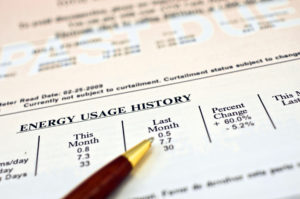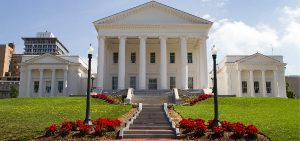Benchmarking Best Practices
Benchmarking has been gaining a lot of attention across the Commonwealth, but it is not a new concept. At its core, benchmarking is the practice of measuring a building’s energy usage and comparing it to the average of similar buildings. It provides building owners with the ability to understand their relative energy performance and identify opportunities to reduce energy waste. According to the U.S. Energy Information Administration, in 2018, buildings accounted for 39% of total U.S. energy consumption.
 2020 legislation mandated the benchmarking of Virginia’s public buildings, which is no small task. There are 10,888 buildings with 117 million square feet of space in the state’s building asset portfolio. In an effort to “lead by example”, the state energy office has developed an energy data warehouse to track and manage this building data. Using energy management dashboards, they are able to highlight energy conservation champions and benchmarking best practices. By pin-pointing areas needing efficiency measures, staff is able to offer support to get innovative technologies implemented, which then help the Commonwealth achieve its energy efficiency goals. Additionally, the state energy office is willing to help interested localities by sharing their energy tracking software.
2020 legislation mandated the benchmarking of Virginia’s public buildings, which is no small task. There are 10,888 buildings with 117 million square feet of space in the state’s building asset portfolio. In an effort to “lead by example”, the state energy office has developed an energy data warehouse to track and manage this building data. Using energy management dashboards, they are able to highlight energy conservation champions and benchmarking best practices. By pin-pointing areas needing efficiency measures, staff is able to offer support to get innovative technologies implemented, which then help the Commonwealth achieve its energy efficiency goals. Additionally, the state energy office is willing to help interested localities by sharing their energy tracking software.
Individual localities have also taken steps to benchmark buildings. Back in 2010-2011, Arlington County instituted the Arlington Green Games, a friendly competition for commercial office buildings to boost energy- and water-savings, waste reduction and recycling, and transportation demand management. This voluntary program had over 100 commercial tenants participating. Scorecards kept track of actions taken, and property managers benchmarked buildings for energy and water usage. After just one year of the competition, the County saw an estimated $2 million in energy and water savings. The County gleaned some important takeaways about voluntary benchmarking from this program.
- Commercial property owners/managers were eager to participate when prizes were awarded and if they could show off their energy-efficient properties
- However, this effort did not achieve market transformation
- Property owners/managers admitted to not including their energy-intensive buildings. This demonstrates the appeal of benchmarking mandates as a public policy tool in order to achieve lasting change through energy-efficient climate action
- It was also labor-intensive to achieve high engagement rates with property owners
Several Virginia localities are already benchmarking their government facilities, including Fairfax County. The live results are publicly available in the County’s energy dashboard. Benchmarking has provided several tangible benefits:
- Internal tracking and recordkeeping, trend analysis, etc.
- Ability to identify opportunities for improvements and to measure and verify savings
- Leading by example
- Provides the platform for long-term awareness, internal and public accountability, and actionability
 Beyond Virginia, cities and counties across the country mandate benchmarking for commercial and public buildings. Just to our north, the District of Columbia passed legislation in 2008 requiring all private buildings greater than 50k square feet and all public buildings greater than 10k square feet to report their annual energy and water use. This program is run through the D.C. Dept. of Energy & Environment (DOEE) in partnership with the D.C. Sustainable Energy Utility (DCSEU). All data is reported through the U.S. Environmental Protection Agency’s free ENERGY STAR Portfolio Manager. DOEE also uses the Standard Energy Efficiency Data (SEED) Program to centralize energy benchmarking data. SEED allows the DOEE to track compliance, enforcement, and communications with building owners and managers.
Beyond Virginia, cities and counties across the country mandate benchmarking for commercial and public buildings. Just to our north, the District of Columbia passed legislation in 2008 requiring all private buildings greater than 50k square feet and all public buildings greater than 10k square feet to report their annual energy and water use. This program is run through the D.C. Dept. of Energy & Environment (DOEE) in partnership with the D.C. Sustainable Energy Utility (DCSEU). All data is reported through the U.S. Environmental Protection Agency’s free ENERGY STAR Portfolio Manager. DOEE also uses the Standard Energy Efficiency Data (SEED) Program to centralize energy benchmarking data. SEED allows the DOEE to track compliance, enforcement, and communications with building owners and managers.
Additional legislation passed reduces the size threshold of the building required to submit annual benchmarking reports. In 2022, buildings greater than 25k square feet will be required to report, and in 2025, buildings greater than 10k square feet will be required. This legislation also established a third-party verification requirement for all covered buildings every three years.
Throughout this process, DOEE and DCSEU have pinpointed several best practices for benchmarking commercial buildings.
- Data quality emails
- Automation
- Trainings/webinars
- Enforcement
- Customer service
Additionally, there have been several challenges faced along the way.
- Staffing (at the start of the program)
- Outreach and engagement
- Reliable data sources
- Access to tools
- Lack of benchmarking knowledge/ no national standard process
 The Virginia Energy Efficiency Council is working with Del. Rip Sullivan on commercial benchmarking legislation for the 2022 General Assembly session. The legislation will allow localities to mandate commercial benchmarking programs within their jurisdiction. We hope to set up the legislation in a way that is beneficial to localities. Therefore, we are facilitating conversations with our local government members who are interested in this topic. We have also met with several benchmarking experts to glean their best practices. Stay tuned for more information, or contact Jessica Greene if you have any questions.
The Virginia Energy Efficiency Council is working with Del. Rip Sullivan on commercial benchmarking legislation for the 2022 General Assembly session. The legislation will allow localities to mandate commercial benchmarking programs within their jurisdiction. We hope to set up the legislation in a way that is beneficial to localities. Therefore, we are facilitating conversations with our local government members who are interested in this topic. We have also met with several benchmarking experts to glean their best practices. Stay tuned for more information, or contact Jessica Greene if you have any questions.
To learn more about benchmarking and any of the programs mentioned above, check out the VAEEC’s Benchmarking Best Practices webinar held in June 2021.
